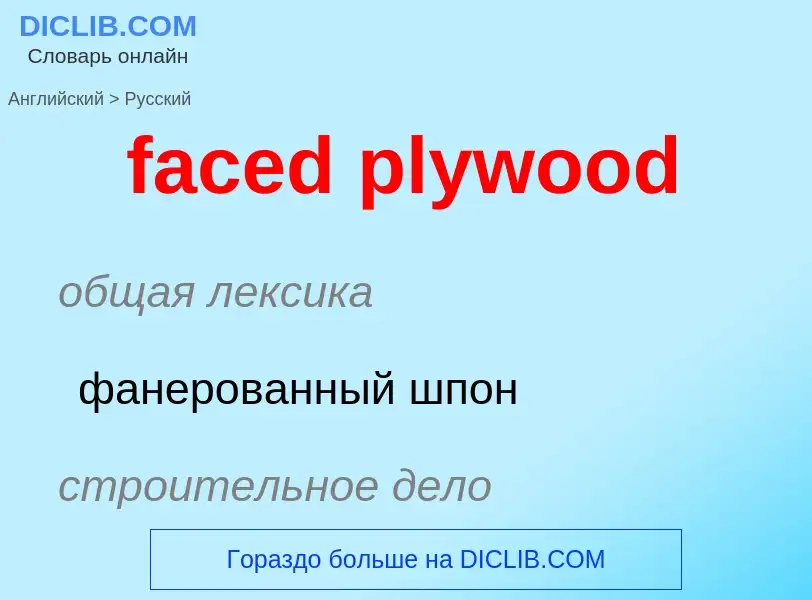Перевод и анализ слов искусственным интеллектом ChatGPT
На этой странице Вы можете получить подробный анализ слова или словосочетания, произведенный с помощью лучшей на сегодняшний день технологии искусственного интеллекта:
- как употребляется слово
- частота употребления
- используется оно чаще в устной или письменной речи
- варианты перевода слова
- примеры употребления (несколько фраз с переводом)
- этимология
faced plywood - перевод на русский
общая лексика
фанерованный шпон
строительное дело
фанера с облицовкой (из другого материала)
['plaiwud]
общая лексика
клееная фанера
лигнолит
фанера
Смотрите также
существительное
общая лексика
(клеёная) фанера
(клееная) фанера
общая лексика
белолицая качурка (Pelagodroma marina)
Смотрите также
общая лексика
оса пятнистая (Vespula maculata)
Смотрите также
Определение
Википедия
Plywood is a material manufactured from thin layers or "plies" of wood veneer that are glued together with adjacent layers having their wood grain rotated up to 90 degrees to one another. It is an engineered wood from the family of manufactured boards which include medium-density fibreboard (MDF), oriented strand board (OSB) and particle board (chipboard).
All plywoods bind resin and wood fibre sheets (cellulose cells are long, strong and thin) to form a composite material. This alternation of the grain is called cross-graining and has several important benefits: it reduces the tendency of wood to split when nailed at the edges; it reduces expansion and shrinkage, providing improved dimensional stability; and it makes the strength of the panel consistent across all directions. There is usually an odd number of plies, so that the sheet is balanced—this reduces warping. Because plywood is bonded with grains running against one another and with an odd number of composite parts, it has high stiffness perpendicular to the grain direction of the surface ply.
Smaller, thinner, and lower quality plywoods may only have their plies (layers) arranged at right angles to each other. Some better-quality plywood products will by design have five plies in steps of 45 degrees (0, 45, 90, 135, and 180 degrees), giving strength in multiple axes.
The word ply derives from the French verb plier, "to fold", from the Latin verb plico, from the ancient Greek verb πλέκω.

![De Havilland DH-98 Mosquito]] was made of curved and glued veneers De Havilland DH-98 Mosquito]] was made of curved and glued veneers](https://commons.wikimedia.org/wiki/Special:FilePath/De Havilland DH-98 Mosquito ExCC.jpg?width=200)
![Detrola]] Model 579 (1946) radio, made of plywood Detrola]] Model 579 (1946) radio, made of plywood](https://commons.wikimedia.org/wiki/Special:FilePath/Detrola Model 579 (1946).jpg?width=200)

![A plywood mill in [[Joensuu]], [[Finland]] A plywood mill in [[Joensuu]], [[Finland]]](https://commons.wikimedia.org/wiki/Special:FilePath/Joensuu plywood mill (1).jpg?width=200)


![Egg - [[MHNT]] Egg - [[MHNT]]](https://commons.wikimedia.org/wiki/Special:FilePath/Pelagodroma marina MHNT.jpg?width=200)



 nest.jpg?width=200)
